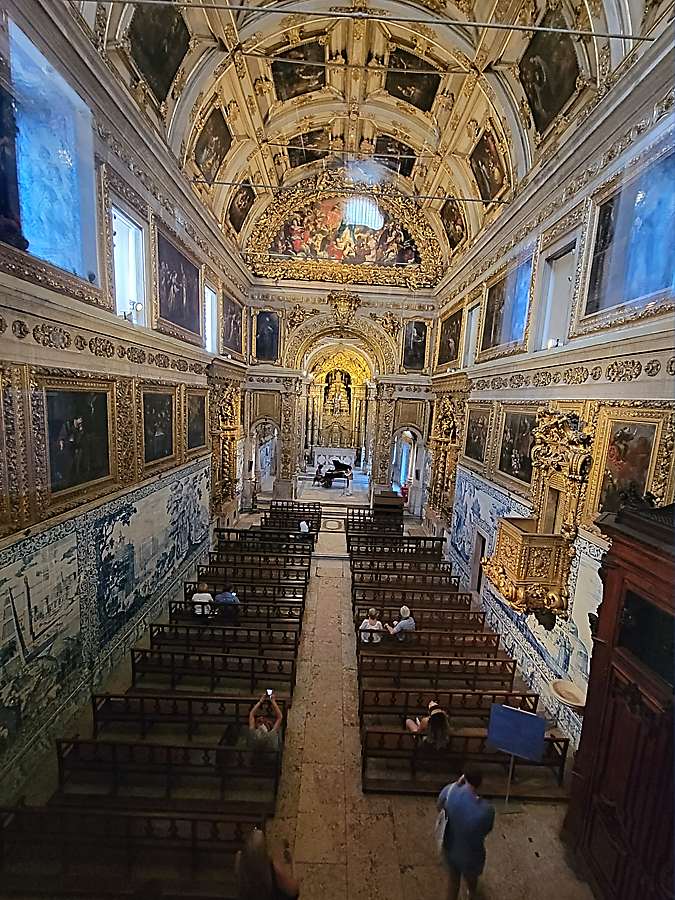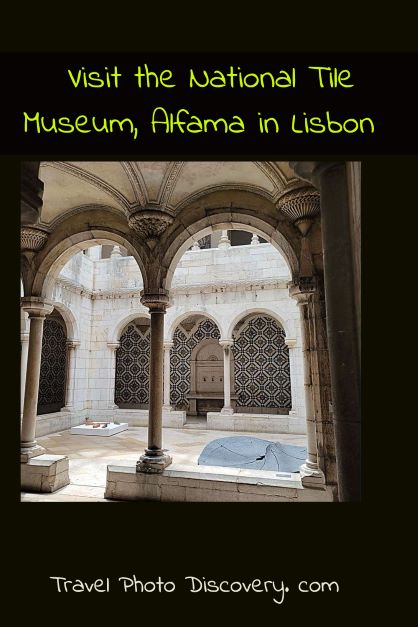Visit the National Tile Museum in Lisbon
I enjoyed this visit to the National Tile Museum in Lisbon in this historic and converted convent in the outskirts of the Alfama district and filled with stunning displays of intricate and gorgeous tiles created for adornment and beauty on the buildings, signage and art saved into amazing collections to explore in the many galleries of the museum.
A visit to the historic National Tile Museum gives a wonderful impression to the country’s history and culture with the creation these beautiful works of tile art or in Portugues “Azulejo”. Used in both functional and decorative applications to important buildings and functional design, the azulejo represents Portuguese artistry and history in this unique and beautiful medium.
The beautiful National Tile Museum of Museo do Azulejo Lisboa shares the evolution of the azulejo tile work throughout the museum’s walls, stairs, and even the church with fine painted details. Magnificent galleries document and trace the history of this craft and importance to ornamentation and the cultural identify of Portuguese tile work in many public and private buildings throughout the country.
Getting to the museum located on the outskirts of the Alfama district is not easy, but a fast Uber or taxi ride can get you to the front entrance very quickly to enjoy this special place in Lisbon.
National Tile Museum in Lisbon (history, tour and historic convent is a must visit)

National Tile museum exhibits and displays
A brief history of Azujelo tiles
The art of azulejo tile was originally conceived from Moorish influence in the area and decoration with Azulayj or polished stone in many of their important structures around the Alfama and other historic monuments.
The Moors ruled Portugal from the year 711 to 1179 and left quite an impression of their art, architecture and tiles on the Spaniards and Portuguese who drove them back to Northern Africa.
But, the main influence of azulejo tiles and decoration actually came from the Spaniards and not the Moors who retreated back to Northern Africa.
During the 15th century, King Manuel I saw the beautiful decorative azulejo tiles in Seville and wanted to have these decorate his palaces in Sintra.
You’ll find many different samples of azulejo tilework while walking around the historic districts of Lisbon from very simple geometric patterns to more ornately decorated or finely painted tiles found in important government, commerce and church buildings around the city.
The most predominant of the tiles are mostly made of blue and white tiles throughout the city and later variations of painted tile included greens and yellows into the detailed tile paintings.
The development of azulejo tiles in Portugal developed into a more well-crafted industry that created a variety of vivid and colorful tiles and more elaborate imagery that included floral, animal and human design into the tile motif into more elaborate creations and prestige that decorated the interiors and exterior facades of important buildings.

National Tile museum exhibits and displays
The former Madre de Deus convent
The National Tile Museum is housed in the Madre de Deus convent on the edge of the alfama district. Founded in 1509 by Queen D. Leonor, the convent and church have some of the most ornate and beautiful tiles located throughout the church and was chosen because of this fine representation of azulejo tile in the building. It also has beautiful baroque details, carvings and ornamentation that balance the beauty of the tile work displays. One of the most unusual things to do in Lisbon is to visit the National Tile Museum in the Alfama district of the city, it’s definitely worth a fast cab ride to get to.
You will see some early displays of these tile creations in simple geometric patterns at the museum in the first few galleries showing the early start of Azulejo creation in the country.
The tile displays show the simple patterns made of azulejo into the dominant “Azul” or blue tile which was in vogue with the fascination of blue porcelain that was being imported from the Ming Dynasty and very popular with European tastes during this timeframe.
Towards the latter part of tile decoration, the craftsmanship started to become more elaborate during the 17th century with the introduction of florals, birds, cherubs, sea life and even humans into the tiled paintings.
The 18th Century is considered the “Golden Age of the Azulejo” with the more complex tiled artwork that covered the most important government, commerce and church buildings in the city and showcasing entire walls, stairs and facades and covering historic, religious and cultural imagery on display.
After a decline in the early 20th century, the azulejo art form came back with larger civic developments going on and tile being used again as a viable art medium to decorate the new metro, public art and new styled architecture within the city.

National Tile museum exhibits and displays
Azulejo details in the stairs, church interiors and cloisters
The scenes of the azulejo tiles in the convent and buildings showcase popular Catholic stories in beautiful details that impresses every visitor to the museum.
Inside the museum, you will see a representation of the azulejo tiles from its early introduction to design and ornamentation to history tour of the tiles development and use through the ages until current day.

Azulejo details in the stairs, church interiors and cloisters
What to see of importance inside the National Tile Museum?

Madre Deus Church
-
Madre Deus Church
This ornate baroque styled church displays elaborate carvings, paintings and gilt work to the Rococo altar and the walls are fashioned in painted tile azulejo depicting important religious events and other holy stories of the Catholic faith.

Upstairs chapel
-
Upstairs chapel
If you go to the upstairs galleries, make your way to the upstairs chapel and the choir area with more elaborate tile displays, carvings and unusual collections on display the in the religious rooms.

Tiled staircase to upper galleries
-
The tiled staircase
The impressive tiled staircase covers both sides of the stairs with finely painted scenes in beautiful details and a detailed look at the advanced craftsmanship that was done even during the time of this convent’s operation.

Cloister area on 2nd level
-
Cloister area
The small cloister is also beautifully crafted with wonderful pillars with beautiful ornamentation and tilework done on the wall areas around the cloisters.

Exhibit galleries
-
Exhibit galleries
There are two levels of galleries that progress from early tile production into more modern art experimentation and expression.
The lower-level galleries trace the Moorish influence with geometric patterns that were predominant during the 16th century. This continues to the more advance techniques and commercial development of azulejo artistry in more common displays and usage. The craftsmanship continues to Mannerist and Baroque timeframes during the 17th Century.
Modern Azulejo galleries at the museum 2nd level

modern tile intrpretations 2nd level
-
Third floor upper gallery
The entire back wall in Room G is a painted tile masterpiece that measures over 75 feet in length. Made with over 1,300 tiles, the piece was created in 1738.
The beautiful tiled painting depicts Lisbon in its glory days before the 1755 earthquake with the many monuments of its day to include the Tower of Belem, Monastery of Belem, Cathedral and Palacio Real in the placa Commercio along with many other structures of importance during that timeframe.
The upper floor galleries continue with Baroque and Neo-Classic styles and develops into the modern approaches and abstract, color blocks and new schools of art developing into the 20th century and into modern interpretations of tiled paintings.
The museum has a collection of more contemporary themed azulejo in the modern galleries along with experimentation and other combined mediums on display and taking this art form into newer levels of presentation and art display.
How to get to the National Tile Museum
Located on the outskirts of the Alfama district in an industrial section of town, the easiest and fastest way to get to the museum is by bus, taxi or Uber. Without having to deal with bus lines, cheap rides on taxi or Uber can get you to the front entrance in no time.
If you take a bus, look for bus # xxx that will come from the Alfama area to the entrance area

A beautiful tiled café to take a break and enjoy more azulejo
A beautiful tiled café to take a break and enjoy more azulejo
IF you are looking for a nice break with refreshments, the café located on the first floor also has an outdoor garden area with seating. The beautiful café is also decorated in azulejo tiles with depictions of kitchen themed images. You’ll see beautiful tiles with ham hocks, sausages, ducks, fish and fruit done in beautiful display and the counter area extends this beautiful craft while worker prepare your food.
Eating can be done indoors in the café or out in the beautiful and lush garden area adjoining the café.
Gorgeous Gift shop
Visiting the Gift Shop at the National Tile Museum is a treat and so tempting to take some souvenirs home when everything is priced reasonably and so beautiful. You can find the gamut of books, jewelry and other objects but the star take aways are the tiles for sale, ceramic pieces and other gorgeous ceramic inspired designs.

Gift Shop at the National Tile Museum
Details to visiting the National Tile Museum
Entry fee for adults is 5 Euro or free with the Lisboa Card (use the display at entrance to mark you card)
Hours: 2:00 pm to 6:00 pm Tues,10:00 am to 6:00 pm Wed-Sun, closed Mon
Website information here for more details
Further reading on Lisbon and Portugal
8 traditional Portuguese foods
Things to do in the Alfama district of Lisbon
Enjoyed the post – please pin it!
Conclusion to visiting the National Tile Museum in Lisbon
Of all the museums to visit in Lisbon, the National Tile Museum in Lisbon should be on your list of worthwhile places to visit here.
Hope that this post has been helpful to planning your visit to the city and if so, please do share it with any of the social media channels and buttons located below.
Disclosure – some of the links above are to affiliate sites that are either reviews or recommendations if you book helps to keep our site running at no additional cost to you. We appreciate your supporting our website meanwhile.







Trackbacks/Pingbacks